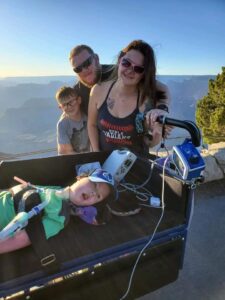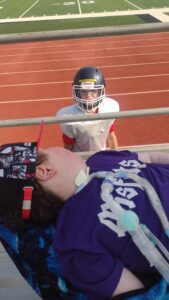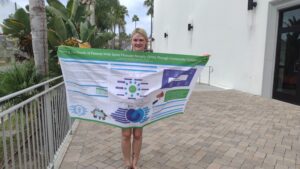Rare Community Profiles

Rare Community Profiles is a new Patient Worthy article series of long-form interviews featuring various stakeholders in the rare disease community, such as patients, their families, advocates, scientists, and more.
Fiercely Advocating for the SMA Community: Why Amanda Will Never Stop Fighting for her Son, Kayden
When Amanda Chaffin welcomed her son Kayden into the world, she was thrilled and excited to expand her growing family. Kayden was joining older brother Brycen, just two years old at the time. Amanda couldn’t wait to see their bond blossom and grow over time. Most of all, Amanda was happy that Kayden seemed safe and healthy. After a high-risk pregnancy, and a birth that required the use of forceps, seeing and holding her son felt like breathing a sigh of relief.
But in the first month after Amanda brought Kayden home, she had the nagging feeling that something wasn’t quite right. He seemed to be missing milestones. His latch and suck while feeding were weak. He didn’t move as much as Amanda expected, and he struggled to hold his head in any way. So she brought it up to the doctor at his one month appointment, but the doctor brushed it off. Says Amanda:
“We were told that it could be a forceps injury, or Kayden could just be a lazy baby. Only time would tell.”
In June of that same year, Kayden developed a rash after his parents completed yard work. They took him to the doctor who immediately noticed some concerning breathing issues and Kayden’s bell-shaped chest. Amanda was directed to take her son to the hospital, where, at just six weeks old, Kayden underwent a flurry of tests. Initially, doctors thought that he might have botulism poisoning from honey ingestion. But Amanda swore that wasn’t the case. Then came the question: had she ever heard of spinal muscular atrophy (SMA)?
Just five days later, the test results came back: Kayden had SMA type 1. As Amanda scrolled through Google late at night while waiting for the follow-up appointment, the results became increasingly frightening. When she arrived at the neurologist at the end of June, she was given just a booklet and a few words that chilled her to her core:
“Go home and love him. He won’t live past his first birthday. You’ll be lucky if he even makes it to Christmas.”
Now, as Kayden has surpassed his tenth birthday, Amanda is sharing their family’s story to explain the impact of a spinal muscular atrophy diagnosis, as well as the need for increased research and advocacy.
What is Spinal Muscular Atrophy (SMA) Type 1?
Spinal muscular atrophy refers to a group of rare, inherited neuromuscular disorders that cause mild-to-severe muscle weakness and degeneration. Most cases result from SMN1 gene mutations which cause the loss of motor neurons in the brainstem and spinal cord. When these motor neurons die, muscles become weakened and atrophied. There are multiple subtypes of SMA, but we’re going to focus on type 1, as this is the form that Kayden has.
SMA type 1 is also known as Werdnig-Hoffman disease. It is considered the most common form of SMA, with about 60% of infants born with SMA having this type. Type 1 also tends to have more severe symptoms, which often manifest before six months of age. Symptoms of SMA type 1 may include:
- Poor suck and swallow reflexes
- Difficulty breathing or coughing
- Developmental delays
- Respiratory muscle weakness
In Kayden’s case, he cannot sit independently, lays flat, and requires complete assistance. Still, says Amanda:
“He has a huge personality. He’s opinionated and very spunky. Even though he doesn’t speak, he still vocalizes and rolls his eyes to get his point across.”

Advocating for Newborn Screening
Newborn screening is a public health initiative. At birth, doctors take a few drops of blood from a newborn’s heel to test for genetic, endocrine, and metabolic disorders. Early identification and treatment can significantly improve outcomes for many conditions. However, testing is not standardized across the United States; there are certain conditions screened in some states that are not screened for in others. You can find a list of what your state screens for here.
In many cases, spinal muscular atrophy is identified during newborn screening; an estimated 99% of babies in the United States are now screened for this disorder. When Kayden was born, Oklahoma did not have SMA as part of the screening panel. The decision to put SMA on the newborn screening panel was passed in 2019 and was not implemented until 2021.
While Amanda’s situation vastly differed from parents who are learning the diagnosis and starting treatment for their children within the first month, she still does what she can to advocate for improved nationwide newborn screening and send resources to push people in the right direction. At the very least, she says, she reminds everyone to take care of themselves—even in the face of the overwhelming cards they were dealt.
Managing the Diagnosis
When the doctor first told Amanda and her husband that Kayden would not live past his first birthday, they were understandably devastated. But that prognosis wasn’t good enough for them. So they pursued a second opinion at another neurologist, one who seemed significantly more informed about SMA (although knowledge of the disease as a whole was still limited). The second neurologist provided more hope and guidance, putting the family on the right path. By the 4th of July, they had acquired a CPAP, suction machine, and a pulse oximeter.
Of course, the CPAP machine had no BIPAP or child settings. Although it was modified for Kayden’s use, it wasn’t as helpful as Amanda had hoped. She realized that he needed a Trilogy. But the path to getting the right device wasn’t easy, says Amanda:
“Nobody prepared me. Nobody trained me. I knew what he needed and nobody listened to me. It took five years before we were approved for the Trilogy. And the fight with insurance is something that most rare disease families deal with. It is constant. Even later, when Kayden needed a platform wheelchair, it took more than a year of fighting insurance and explaining why this would improve his quality of life. Everything is such a fight and these kids are falling through the gaps.”
In August, when Kayden was just six months old, he underwent his first surgery to get a g-tube. Just a few months later, he had a cold and coded at home. Then, in December, he coded for a second time, necessitating a trip to the hospital. He had RSV and a collapsed lung. Doctors intubated him for six weeks.
However, extubation went much less smoothly. Eventually, shares Amanda:
“Doctors came in and told me that extubation had failed. I was given the option of either giving him morphine and letting him pass comfortably in his sleep, or a tracheotomy with permanent ventilation. We chose the latter.”
After spending three additional months in the hospital, Kayden came home right before his first birthday—a stark contrast to what doctors originally said.
An Unexpected Obstacle
In June 2015, Amanda’s husband was building power lines and loading poles onto a truck. A pole fell off and struck him. He was transported to the hospital with 15 facial fractures, a torn patellar tendon, and a pelvic fracture. Doctors said that he was lucky; the accident should have been fatal. After spending weeks in the hospital, he returned home in a wheelchair. Suddenly, Amanda found herself caring for her husband and sons, two of whom were in wheelchairs.
While this was challenging, Amanda also felt a pervasive sense of relief: her husband and son were both alive. They were there, with her. But this relief was underlaid with grief and trauma and fear. Luckily, her husband recovered and the family went on with their lives.

In 2016, the FDA approved the first ever treatment for spinal muscular atrophy: Spinraza (nusinersen). Amanda knew that she had to get Kayden on it. Once again, she found herself facing a fight with insurance. She explains:
“Kayden was the 2nd child in Oklahoma dosed with Spinraza. Insurance initially declined it for any children with trachs, since there were no kids with trachs in the trial.”
But she would not give up. She shared her story far and wide, through every news outlet and blog she could speak to. And eventually, in August 2017, Kayden gained access to the drug. He remained on this treatment until 2020, when the family switched him to Evrysdi (risdiplam), approved that same year.
Kayden Today
Today, Kayden is about to head into the 5th grade. He has traveled with his family to the Grand Canyon and Las Vegas, and loves spending time with Brycen—especially if they’re watching Hotel Transylvania! Even while not watching movies, Kayden loves seeing Brycen play golf, baseball, and football.

Learning to balance the brothers’ needs was initially difficult, shares Amanda. A few years ago, her eldest son made an offhand comment that Amanda spent more time with Kayden because she loved him more. Says Amanda:
“That hurt as a parent. Now that Brycen is getting older, he understands more of why Kayden needs more attention. But I also do my best to explain more and to spend more time one-on-one. We do ‘day dates’ where I’ll take Brycen to eat or to the library, just so that we can have those little moments together. I feel like that is something that needs to happen more—the non-affected children getting some personal family time—but I also recognize that not everybody has the help and support to make that happen.”
Finding a Community Through Advocacy
Immersing herself in the community, and working towards meaningful change, has helped Amanda find focus and connect with others. She began as the Cure SMA Chapter Lead for Oklahoma in 2018, then joined the Fighting for Kaiden Foundation as Secretary in 2021. She explains:
“The Fighting for Kaiden Foundation is a non-profit organization committed to enhancing the lives of those struggling with Spinal Muscular Atrophy (SMA) on multiple fronts. Directly, we strive to raise awareness of the disease on the local, regional and national levels. Our foundation provides need-based financial support to affected families for equipment and travel. We understand the value of peer support and organize support groups and information for SMA affected families in our area. We provide directed donations for medical research in addition to medical equipment and services for SMA patients across the US. Our goals are driven by our devotion to improving the lives and finding a cure for those with SMA.”
The Fighting for Kaiden Foundation offers resources, sends families to conferences when possible, and even distributes wheelchairs. After a small Panthera wheelchair was discontinued last year, the Foundation managed to purchase and distribute 25 wheelchairs from the manufacturer to families in need. When the families are done, or graduate to other chairs, the Foundation will fix the wheelchairs and disperse them again.
In addition to attending conferences and getting a certificate from the Patients Rising masterclass, Amanda continues to find new ways to give back.

As she looks back on her journey from diagnosis to now, one thing is clear: there was a genuine lack of mental and emotional health support from doctors, friends, and even family. Some of their family hasn’t seen Kayden in over six years; they don’t want to see him because of his illness. Says Amanda:
“It’s painful and my heart hurts for my boys. Unfortunately, that’s how it is and that’s the ugly side of a rare disease diagnosis. To me, this is exactly why families need more mental health support: at diagnosis, at newborn screening, throughout treatment. This journey comes with a lot of painful and unexpected moments. It is mentally and emotionally draining. You’re dealing with a terminal disease on top of everything else, and having that support can be unbelievably helpful for people while they’re in the middle of this. It took me nine years to take care of myself, so now I just try to provide that same comfort to others.”
Part of how Amanda uplifts her community, and pushes for mental health support, is through the Cure SMA – Oklahoma Chapter Facebook group. When people reach out to her, she offers her family’s experience and connects them to resources. At the end of the day, she shares:
“If I can help just one person, or make a change in just one person’s life, that warms my heart. That means everything to me.”


